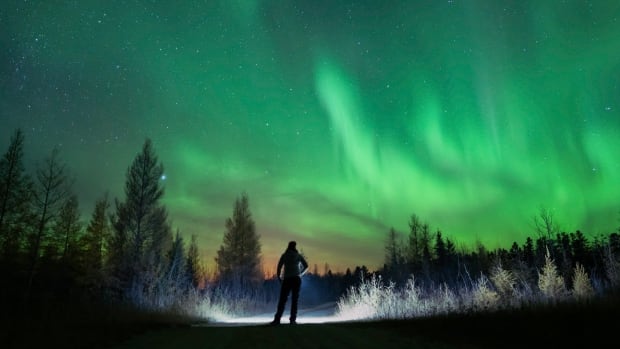Sask. photographer who sees magic of the night sky says it needs protection | CBC News
Jeanine Holowatuik keeps her camera gear stashed by the door, ready to go at a moment’s notice.
The astrophotographer spends her time chasing the northern lights, waiting for waves of green and purple to start dancing across the sky.
“I could be in the middle of nowhere all by myself, just screaming, all excited at the sky, because it’s just so unbelievable. It could be raining down light in every direction,” said Holowatuik, who lives near Hudson Bay, Sask.
“There’s just something magical about the night sky. It has this way to calm you and excite you and bring out the curiosity.”
Holowatuik wants others to experience that magic. She teaches photography, leads aurora tours and speaks at conferences.
But she also wants people to know that the dark skies, as people have known them, are under threat as space and light pollution increases.
“When I first started photography, I would see a couple satellites in my photos throughout the night. Now, eight years later, I’ll see at least a dozen satellites in one six-second exposure.”

A changing sky
Samantha Lawler has also observed the night sky becoming more crowded, both with her eyes and her research data captured by large telescopes.
“It’s really sad to see something that humans have had access to for all of human history, changing in real time,” said the astronomer, who lives on a rural farm outside of Regina. She is also an associate professor with Campion College at the University of Regina.
“There’s so much traditional knowledge from cultures around the world that’s wrapped up in watching the constellations or the position of the Milky Way.”
She’s been studying how recently launched satellites are changing the night sky — and describes what’s to come as depressing and horrifying.
Urban light pollution has been a concern for night sky observers for years, she noted, but people have escaped it by travelling away from cities.
Satellite light pollution knows no boundaries.
‘No regulations’: astronomer
Lawler said there are roughly 7,000 satellites in orbit, and that number could grow to 65,000 if companies go through with their launch plans.
If that happens, Lawler said one out of every 15 points of light for sky observers in Saskatchewan would actually be a moving satellite — a canopy of twinkling stars transformed into a chaotic city street network.
But it doesn’t have to be that way. Lawler said companies can make changes to reduce the impact of satellite pollution. Lawler said some concerns could be addressed through technology — making lights fainter, adding sun shades, changing the satellites’ shape or material or capacity.
However, there’s not an urgent push for companies to make changes.
“There’s no regulations, there’s nobody in control. In order to launch Starlink satellites, Starlink just has to get permission from one U.S. federal agency, even though these satellites fly over countries all over the world.”
She said people should know about what’s at stake and speak up if they are concerned.
Sask. offers special views
Holowatuik is focused on raising awareness. She plans to keep sharing her images of the night sky as it is now, and talking about the need for dark sky protection.
The issue hits close to home as her photography is focused in Saskatchewan.
She said the sky seen from this province is particularly special for aurora chasers, because the northern lights are still visible in the summertime — something not common around the globe.
Noctilucent clouds — thin clouds that seem to glow in the twilight — and the Milky Way’s core can also be seen clearly at the right time.
“I love the feeling of being out somewhere under the stars, just watching the night sky. It’s so peaceful,” she said.
“Future generations need to be able to see the beauty of the night sky like we see it now.”
For all the latest Technology News Click Here

